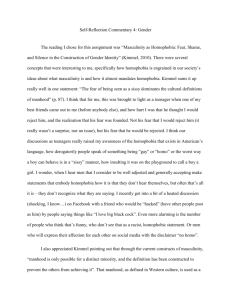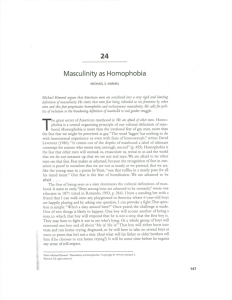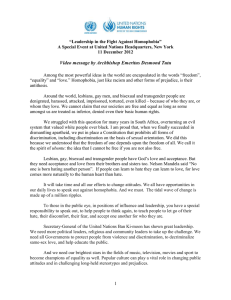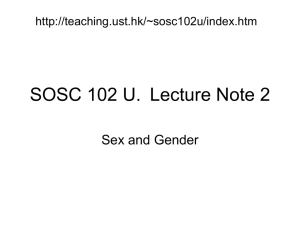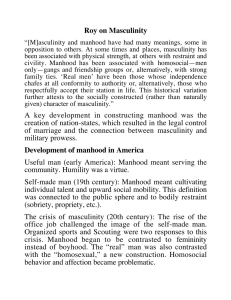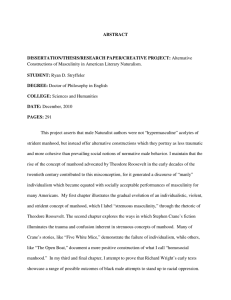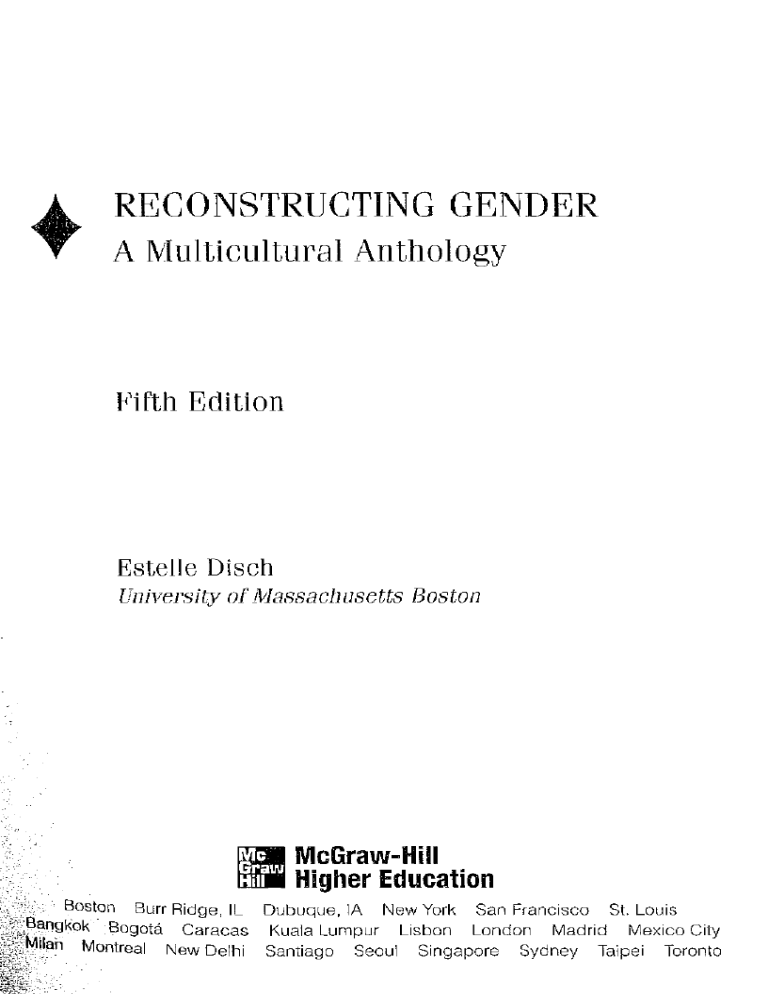
•
RECONSTRUCTING GENDER
A Multicultural Anthology
Fifth Eclition
Estelle Disch
UnNersUy of Ivlassac1l1lsetts Boston
_
_
McGraw-Hili
Higher Education
Boston Burr Ridge, IL Dubuque, IA New York San Francisco St. Louis
Bogota Caracas Kuala Lumpur Lisbon London Madrid Mexico City
Montreal New Delhi Santiago Seoul Singapore Sydney Taipei Toronto
'.'isHlAm,knk
McGraw-Hili
Higher Education
Published by McGraw-Hill, an imprint of The McGraw-Hill Companies, Inc., 1221 Avenue of
the Americas, New York, NY 10020. Copyright e 2009, 2006, 2003, 2000, 1997. All rights
reserved. No part of this publication may be reproduced or distributed in any form or by any
means, or stored trt a database or retrieval system, without the prior written consent of The
McGraw-Hili Companies, Inc., including, but not limited to, in any network or other
electronic storage or h-ansmissioTI, or broadcast for distance learning.
This book is printed on acid-free paper.
1234567890DOC/DOCI098
ISBN,978-0-07-338006-3
MElD,0-07-338006-7
Editor in Chief: Michael Ryml
Publisher: Fnmlc Mortimer
Sponsoring Editor: Gino Boedeker
Executive Marketing Manager: Leslie OberJntber
Developmental Editor: Kate Scheil1ll1l111
Editorial Coordinator: Evan Bode
Production Editm: Karol Jurado
Production Service: Anne D1ULlS, Scrntchgmve! Ptlblishing Services
Manuscript Editor: Pat TompkiHs
Cover Designer: Laurie Entringer
Production Supervisor: Richard DeVitto
Composi.tion: 10/12 Book AntiqH[l by ICC MllCI11i1!ml [nc.
Printing: 45# New Era MaHe Plus, R. R. DOH/wHeN & Sons
Cover image: Luz-Ines Mercier. Down to Em'th, 1996. Mixed Media on Canvas, 41 X 60."
© Luz-mes N(ercier
Library of Congress
Cataloging~in-PublicationData
Reconstructing gender: a multicultural anthology /[edited by] Estelle Disch.-5th ed.
p.cm.
Includes bibliographical references and indexes.
lSBN-H 978-0-07-338006-3 (alk paper)
ISBN-lOo 0-07-338006-7 (alk. paper)
1. Sex role. 2. Masculinity. 3. Femininity. 4. Women-Psychology. 5. Socialization.
1. Disch, Estelle.
HQJ07S.R432009
30S.3-dc22
2007032975
The Internet addresses listed ll"l the text were accurate at the time of publication. The inclusion
of a Web site does not indicate an endorsement by the authors or McGraw-Hill, and McGrawHill does not guarantee the accuracy of the information presented at these sites.
www.mhhe.com
Mnsculinittj as Homophobia
149
16
MASCULINITY AS HOMOPHOBIA
MICHAEL S. KIMMEL
Michael S. Kimmel is professor of sociology at SUNY at Stony Brook. His many
books include: Manhood in America (2005, 2nd edition), The Gendered Society (2004),
and, coedited with Michael A.
Messnel~
Men's Lives (2006, 7th edition).
ven if we do not subscribe to Freudian psychoanalytic ideas, we can still
observe how, in less sexualized terms, the father is the first man who
evaluates the boy's masculine performance, the first pair of male eyes
before whom he tries to prove himself. Those eyes will follow him for the rest
of his life. Other men's eyes will join them-the eyes of role models such as
teachers, coaches, bosses, or media heroes; the eyes of his peers, his friends, his
workmates; and the eyes of millions of other men, living and dead, from whose
constant scrutiny of his performance he will never be free. "TIle tradition of all
the dead generations weighs like a nightmare on the brain of the living," was
how Karl Marx put it over a century ago (1848/1964, p. 11). "The birtlu'ight of
every American male is a chronic sense of personal inadequacy," is how two
psychologists describe it today (Woolfolk & Richardson, 1978, p. 57).
That nightmare from which we never seem to awaken is that those other
men will see that sense of inadequacy, they will see that in oW' own eyes we
are not who we are pretending to be. What we call masculinity is often a
hedge against being revealed as a fraud, an exaggerated set of activities that
keep others from seeing through us, and a frenzied effort to keep at bay those
fears within ourselves. Our real fear, "is not fear of women but of being
ashamed or humiliated in front of other men, or being dominated by
stronger men" (Leverenz, 1986, p. 451).
This, then, is the great secret of American manhood: We are afraid ofother
men. Homophobia is a central organizing principle of our cultural definition
of manhood. Homophobia is more than the irrational fear of gay men, more
than the fear that we might be perceived as gay. "The word 'faggot' has nothing to do with hOlllosexuaI experience or even with fears of homosexuals,"
writes David Leverenz (1986). "It comes out of the depths of manhood: a
label of ultimate contempt for anyone who seems sissy, unto ugh, uncool"
E
Michael S. Kimmel, excerpt from "Masculinity as Homophobia: Fear, Shame, and
Silence in the Construction of Gender Identity," in Theorizing Masculinities, ed. H. Brad
(TIl0usand Oaks, CA: Sage, 1994), pp. 119-41. Copyright © 1994 by Michael S. Kimmel.
All rights reserved.
150
Genda Socialization
(p. 455). Homophobia is the fear that other men will unmask us, emasculate
us, reveal to us and the world that we do not Ineasure up, that we are not real
men. We are afraid to let other men see that fear. Fear makes us ashalned, because the recognition of fear in ourselves is proof to ourselves that we are not
as manly as we pretend, that we are, like the young Inan in a poem by Yeats,
"one that cuffles in a manly pose for all his timid heart." Our fear is the fear
of hU1l1iliation. Vie are ashamed to be afraid.
Shame leads to silence-the silences that keep other people believing
that we actually approve of the things that are done to women, to minorities,
to gays and lesbians ilL our culture. The frightened silence as we scurry past
a woman being hassled by men on the street. That furtive silence when men
make sexist or racist jokes in a bar. That clammy-handed silence when guys
in the office make gay-bashing jokes. Our fears are the sources of our
silences, and men's silence is what keeps the system running. This might
help to explain why women often complain that their male friends or partners are often so understanding when they are alone and yet laugh at sexist
jokes or even make those jokes themselves when they are out with a group.
The fear of being seen as a sissy dominates the cultural definitions of
manhood. It starts so early. "Boys among boys are ashamed to be umnanly,"
wrote one educator in 1871 (cited in Rotundo, 1993, p. 264). 1 have a standing
bet with a friend that I can walk onto any playground in America where
6-yem-old boys are happily playing and by asking one question, I can provoke a fight. That question is simple: "Who's a sissy around here?" Once
posed, the challenge is made. One of two things is likely to happen. One boy
will accuse another of being a sissy, to which that boy will respond that he is
not a sissy, that the first boy is. They may have to fight it out to see who's
lying. Or a whole group of boys will surround one boy and all shout "He is!
He isl" That boy will either burst into tears and run home crying, disgraced,
or he will have to take on several boys at once, to prove that he's not a sissy.
(And what wilJ his father or older brothers tell him if he chooses to run home
crying?) It will be some time before he regains any sense of self-respect.
Violence is often the single most evident marker of ITlanhood. Rather it is
the willingness to fight, the desire to fight. The origin of our expression that
one has a chip on one' 5 shoulder lies in the practice of an adolescent boy in
the country or small town at the turn of the century, who would literally
walk around with a chip of wood balanced on his shoulder-a signal of his
readiness to fight with anyone who would take the initiative of knocking the
chip off (see Gorel; 1964, p. 38; Mead, 1965).
As adolescents, we learn that our peers are a kind of gender police, constantly threatening to u111TIask us as feminine, as sissies. One of the favorite
tricks when I was an adolescent was to ask a boy to look at his fingernails. If
he held his palm toward his face and curled his fingers back to see them, he
passed the test. He'd looked at his nails "like a man." But if he held the bac!<
of his hand away from his face, and looked at his fingernails with arm outstretched, he was immediately ridiculed as a sissy.
Masculinity as Homophobia
151
As young ll1en we are constantly riding those gender boundaries, checking the fences we have constructed on the perin1eter, n1aking sure that nothing even remotely feminine might show through. The possibilities of being
munasked are everywhere. Even the ill0St seelningly insignificant thing can
pose a tlueat or activate that haunting terror. On the day the students in my
COUIse "Sociology of Men and ivIascullnities" were scheduled to discuss homophobia and male-male friendships, one student provided a touching illustration. Noting that it was a beautiful day, the first day of spring after a brutal
northeast wintel~ he decided to wear shorts to class. "1 had this realIy nice pair
of new Madras shorts," he commented. "But then I thought to myself, these
shorts have lavender and pink in them. Today's class topic is homophobia.
Maybe today is not the best day to wear these shorts."
OUf efforts to maintain a manly hont cover everything we do. What we
wear. How we talk How we walk. What we eat. Every mannerism, every
movement contains a coded gender language. Think, for example, of how
you would answer the question: How do you "know if a man is homosexual? When I ask this question in classes or workshops, respondents invariably provide a pretty standard list of stereotypically effeminate behaviors.
He walks a certain way, talks a certain way, acts a certain way. He's very emotional; he shows his feelings. One woman commented that she "knows" a
man is gay if he really cares about her; another said she knows he's gay if he
shows no interest in her, if he leaves her alone.
Now alter the question and in1agine what heterosexual men do to make
SlUe no one could possibly get the "wrong idea" about them. Responses typically refer to the original stereotypes, this time as a set of negative rules
about behavior. Never dress that way. Never talk or walk that way. Never
show your feelings or get en1otiona1. Always be prepared to demonstrate
sexual interest in women that you meet, so it is impOSSible for any woman to
get the wrong idea about you. In this sense, homophobia, the fear of being
perceived as gay, as not a real man, keeps men exaggerating all the traditional rules of masculinity, including sexual predation with WOlnen.
Homophobia and sexism go hand in hand.
The stakes of perceived sissydom are enormous-sometimes lllatters of
life and death. We take enormous risks to prove our manhood, exposing
ourselves disproportionately to health risks, workplace hazards, and stressrelated illnesses. Men cOilllnit suicide three times as often as women.
Psychiatrist Willard Gaylin (1992) explains that it is "invariably because of
perceived social hUlniliation/' most often tied to failure in business:
ll
Men becOlne depressed because of loss of status and power in
the world of men. It is not the loss of money, or the material
advantages that money could buy, which produces the despair that
leads to self-desh"uction. It is the "shame," the "humiliation," the
sense of personal"failure." ... A lnan despairs when he has ceased
being a man among men. (p. 32)
152
Gellder Socinlizntioll
tn one survey, vVOlnen and rnen were asked what they were Inost afraid
of. vVOlnen responded that they vvere most afraid of being raped and 1l1UTdered. iYfen responded that they were 1110St afraid of being laughed at
(Noble, 1992, pp. 105-106).
Power anel Powerlessness in the Lives of Men
r have argued that h01110phobia, Inen' 5 fear of other ll1en, is the aninlating
condition of the dominant definition of masculinity in America, that the
reigning definition of lTmsculinity is a defensive effort to prevent being elll.ascuiated. In our efforts to suppress or overcaIl1e those fears, the d0111inant
culture exacts a trenlendous price from those deen1ed less than fully lnanl)':
WOlnen, gay luen, nonnative-born men, ITl.en of color. This perspective lnay
help clarify a paradox in llien's lives, a paradox in which ITl.en have virtually
a1l the power and yet do not feel powerful (see Kaufman, 1993).
NJanl"1ood is eguated vvitb power-over wonlen, over other luen.
Everywhere we look, we see the institutional expression of that power-in
state and nationallegislaturesr on the boards of directors of every Inajor U.S.
corporation or law fifnl, and in every school and hospital administration.
iNOlnen have long understood this, and feminist WOlT'Ien have spent the past
three decades challenging both the public and the private expressions of
men's pm-ver and acknowledging their fear of men. Felninisll'l as a set of theories both explains women's fear of lnen and empowers WOD'len to confront it
both publicly and privately. Feminist women have theorized that masculinity
is about the drive for domination, the drive for power, for conquest.
This fenlinist definition of luasculinity as the drive for power is theorized fronl WOluen' 5 point of view. It is how women experience Inasculinity.
But it assumes a symmetry between the public and the private that does not
confornl to men's experiences. Feminists observe that WaHlen, as a group, do
not hold pm-ver in our society. They also observe that individually, they, as
women, do not feel powerful. They feel afraid, vulnerable. Their observation
of the social reality and the iT individual experiences are therefore symlnetrical. Feinnusm also observes that Inen, as a group, are in power. Thus, with
the sante sylnmetry, feminisln has tended to assunle that individually men
must feel powerful.
This is why the fCll1inist critique of masculinity often falls on deaf ears
with lnen. When confronted with tIle analysis that 11len have ail the poweri
IYl.uny lnen react incredulously. "What do you lnean, 11len have all the
power?" they ask. "What are you talking about? Wly wife bosses l1'le around.
My kids boss me around. l\IIy boss bosses Inc 3Tound. 1 have no power at
I'm completely powerless!"
IvIen's feeiings are no t the feelings of the povverfuJ, but of those who
thenlselves as powerless. These are the feelings that CGlue inevitably fr011l
the discontinuity between the social and the psychological, between
Masculinity as Homophobia
153
aggregate analysis that reveals how men are in power as a group and the
psychological fact that they do not feel powerful as individuals. They are
the feelings of Inell who "V ere raised to believe themselves entitled to feel
that power, but do not feel it. No wonder many men are frustrated and
angry.
This may explain the recent popularity of those workshops and retreats
designed to help men to claim their "inner" powel~ their "deep manhood,"
or their "warrior within." Authors such as Ely (1990), Moore and Gillette
(1991, 1992, 1993a, 1993b), Farrell (1986, 1993), and Keen (1991) honor and
respect 111en'S feelings of powerlessness and acknowledge those feelings to
be both true and real. "They gave white men the semblance of power," notes
John Lee, one of the leaders of these retreats (quoted in Ferguson, 1992, p. 28).
"We'll let you run the country. but in the meantime, stop feeling, stop talking,
and continue swallOWing your pain and your hurt." (We are not told who
"they" are.)
Often the purveyors of the mythopoetic men's movement, that broad umbrella that encompasses all the groups helping men to retrieve this mythic
deep ll1anhood, usc the ilnage of the chauffeur to described luodern man's position. The chauffeur appears to have the poyver-he's wearing the uniform,
he's in the driver's seat, and he knows where he's going. So, to the observel~
the chauffeur looks as though he is in command. But to the chauffeur himself,
they note, he is merely taking orders. He is not at all in charge.'
Despite the reality that everyone knows chauffeurs do not have the power,
this image remains appealing to the men who hear it at these weekend workshops. But there is a missing piece to the image, a piece concealed by the framing of the image in terms of the individual man's experience. That missing
piece is that the person who is giving the orders is also a man. Now we have a
relationship between Inen-between men giving orders and other men taking
those orders. The man who identifies with the chauffeur is entitled to be the
man giving the orders, but he is not. ("They" it turns out, are other men.)
The dimension of po-wer is now reinserted into men's experience not
only as the product of individual experience but also as the product of relations with other men. In this sense, men's experience of powerlessness is
renl-the men actually iee! it and certainly act on it-but it is not true, that is,
it does not accm"ately describe their condition. In contrast to women's lives,
men's lives are structured around relationships of power and men's differential access to power, as well as the differential access to that power of lnen as
group. Our imperfect analysis of our own situation leads us to believe that
men need 1110re power, rather than leading us to support feminists'
to rearrange power relationships along Inore equitable lines.
Philosopher Hannah Arendt (1970) fully understood this contradictory
;,,~xperj,en(:e of social and individual power:
Power corresponds to the human ability not just to act but to act in
Concert. Power is never the property of an individual; it belongs to
154
Gender SocinUzatio/l
a group and ren1ains in existence only so long as the group keeps
together. When we say of somebody that he is "in power" we
actually refer to his being enlpovvered by a certain lTUlnber of
people to act in their n3m.e. The Inoment the group, from which the
parver originated to begin with, .. disappears, his "povver" also
vanishes. (p. 44)
Why, then, do Alnerican l11en feel so powerless? Part of the ansvver is because we've constructed the rules of ll1anhood so that only the tiniest fraction
of lnen come to believe that they are the biggest of \ovheels, the sturdiest ot
oaks, the lllost virulent repudiators of Eenlininity, the 1110St daring and
aggressive. We've nlanaged to disernpower the overwhel111ing Inajority of
Anlerican Inen by other Ineal1s-such as discriminabng on the basis of raCE,
class, ethnicity, age, or sexual preference.
Nfasculinist reh"eats to retrieve deep, wounded Inasculinity are but one of
the ways in which American l1"lel1 currently struggle with their fears and theil"
shame. Unfortunately, at the very moment that they work to break down the
isolation that governs IHen's lives, as they enable 111en to express those fears
and that shanle, they ignore the social power that l1"len continue to exert over
women and the privileges from which they (as the middle-aged, middle-class
white men who largely make LLp these ret1'eats) continue to benefit-regardleSS.,i,1
of their experiences as wounded victims of oppressive male socialization.
.
Othe1's still rehearse the politics of exclusion, as if by clearing away the
playing field of secure gender identity of any that we deem less than
manly-women, gay men, nonnative-born men, lTIen of color-middle-class,
i.,~"i
straight, white men can reground their sense of thelTIselves without those.
haunting fears and that deep shame that they are unmanly and wi11 be
exposed by other men. This is the Inanhood of racislll, of sexls1n, of homophobia. It is the manhood that is so chronically insecure that it trembles at the ·I.i
idea of lifting the ban on gays in the military, that is so threatened by WOll1en
in the workplace that women beCOlue the targets of sexual hm·assment that
is so deeply frightened of equality that it must ensure that the playing Held "i.'o'l
of male competition relllains stacked against all newcanlers to the gmne.
.
Exclusion and escape have been the dOlninant methods American lueri
have used to keep their fears of hun"liliabon at bay. The fear of emasculation i
by other lTl.en, of being humiliated, of being seen as a sissy, is the leitlnotif _-'.:·1:,;1
in my reading of the history of Alnerican manhood. lVlasculinity has beconte . .
a relentless test by which we prove to other luen, to WOluen, and ultinlately j
to ourselves, that we have successfully Inastered the part. The restlessness 'j
that nlen feel today is nothing neyv in Alnerican history; we have been anx.il
ious and restless for ahnost two centuries. Neither exclusion nor escape has ,J
ever brought us the relief we've sought, and there is no reason to think that, j
either will solve our proble.ms now. Peace of Injnd~ relief frOln gender strug.: '::1
gle, will come only from a politics of inclusion, not exclusion, from standin~
up for equality and justice, and not by rU1Uling aV\Tay.
"5J
I
I
I
f
11
i
1
j
ill
lVlaswliJ1ity as Homophobia
155
NOTE
1. The image is from ·Warren Farrell, who spoke at a workshop I attended at the
First International Men's Conference, Austin, Texas, October 1991.
REFERENCES
Arendt, H. (1970). On revolution. New York: Viking.
Bly, R. (1990). Iron John: A book about men. Reading, MA: Addison-vVesley.
Farrell, W. (1986). Why men are the way they are. New York: McGraw~Hil1.
Farrell, W. (1993). The myth of mille po'wer: Why men are the disposable sex. New York:
Simon & Schuster.
Ferguson, A. (1992, January). America' 5 new men. Amedcan SpectatOJ: 25 (1).
Carlin, W. (1992). The male ego. New York: Viking.
Gorel~ G. (1964). The American people: A study in national character. New York: Norton.
Kaufman, :tvi. (1993). Cracking the armour: Power and pain in the lives of men. Toronto:
Viking Canada.
Keen, S. (1991). Fire in Il,e belly. New York: Bantam.
Leverenz, D. (1986, Fall). Ivlanhood, humiliation and public life: Some stories.
Southwest Review, 71.
Marx, 1<., & Engels, F. (1848/1964). The communist manifesto. In R. Tucker (Ed.), The
lvlarx-Engels reader. New York: Norton.
Mead, 1\11. (1965). And keep your powder dry. New York: \Nilliam Morrow.
Moore, R, & Gillette, D. (1991). King, warrior, magician lover. New York Harper
Collins.
Moore, R., & Gillette, D. (1992). The king within: Accessing the king in the male psyche.
New York: William Morrow.
Moore, R, & Gillette, D. (1993a). The wanior within: Accessing the warrior in the male
psyche. New York: \Nilliam Morrow.
Moore, R, & Gillette, D. (1993b). The magician within: Accessing the magician in the male
psyche. New York: William l\I[orrow.
Noble, V. (1992). A helping hand from the guys. In K. L. Hagan (Ed.), Women respond
to the men's movement. San Francisco: HarperCollins.
Rotundo, E. A. (1993).American manhood: Transformations in mascuLinih) from the revolution to the modern era. New York Basic Books.
Woolfolk, R L., & Richardson, F. (1978). Sanity, stress and survival. New York Signet.

